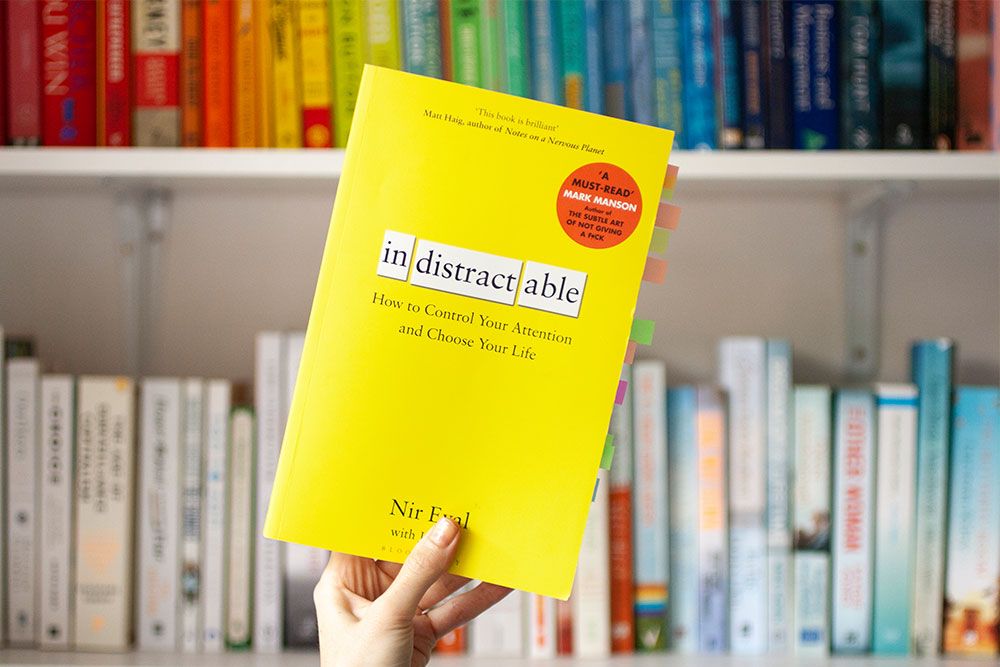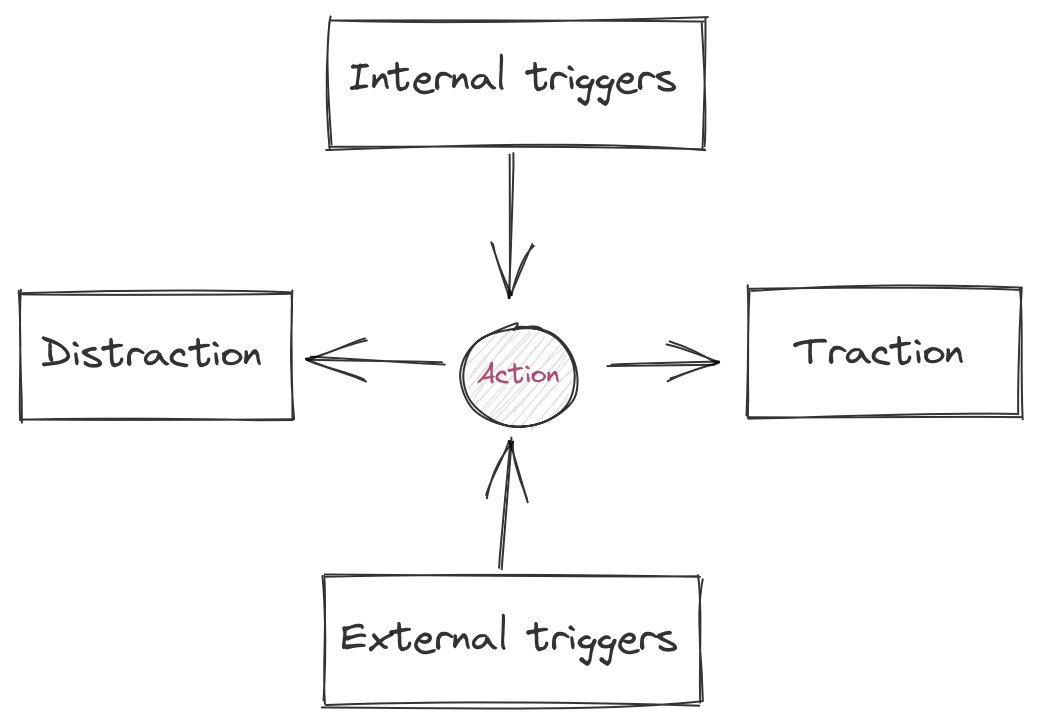It’s Not Technology. It’s You.
What I learned from the bestselling book ‘Indistractable’ by Nir Eyal

Update: this book review was selected as a winning submission for the 1729.com Indistrictable Book Review assignment, earning me $100 in BTC. 🤸♀️
Have you seen The Social Dilemma?
When the Netflix documentary came out, it seemed like everyone (myself included) was screaming hysterically about how evil tech giants have been brainwashing us. No wonder we’re all so anxious and unable to focus on anything for longer than 30 seconds.
Yet, something about it did not sit right with me. Sure, tech companies need stricter regulation, and absolutely, addictive app design is problematic. I’m not saying we should let tech off the hook, or all responsibilities lie with the individual. However, I don’t like the idea of us being completely powerless — controlled and played like a mass of puppets on strings. We still have a say in how we spend our time, and we don’t have to let ourselves be so easily manipulated.
This is exactly what Indistractable, a bestselling book by Nir Eyal, is all about — empowering people to take back control and, in Nir’s words, “get the best out of technology without technology getting the best of us.”
Split into two halves, Indistractable talks about the causes and triggers for distraction followed by strategies and tactics for managing it in various contexts such as at work, in the home, and with family. In this piece, I’ll focus on the first half of the book, which I felt was the strongest, as well as how I will (try really hard to) use some of the ideas to battle my own biggest distraction.
Being Indistractable Is a Modern Superpower
Before we jump in, let’s quickly talk about why this is so important.
Imagine if you always did exactly what you promised yourself you would do. How much more would you have accomplished by now? How much happier would you be? No more procrastinating, no more feeling guilty and being hard on yourself at the end of the day.
It’s not about being a hyper-ambitious, always-on, overachieving person. It doesn’t need to be about big, audacious goals. It’s simply about doing what you said you would do. Whatever that is.
If that sounds too basic, try thinking back over your last couple of days and ask yourself: did you finish that presentation you said you were going to work on? Did you go for that run? Did you cook your own meal instead of ordering takeout? We are constantly thinking of all the things we ‘should’ get done yet somehow don’t get around to it because we get sidetracked by other stuff.
Most people either won’t recognise there is an issue or won’t have the discipline to do something about it. That means that, in our global information economy, it will become a competitive advantage to be Indistractable — having the ability to focus deeply and adding value beyond shallow work. To produce the absolute best stuff you are capable of producing by the time you said you would.
The few who are able to cultivate this skill will thrive.
How to Become Indistractable
In the book, Nir outlines a four-step model as a guide to becoming Indistractable.
Every action we take leads to either traction or distraction and is prompted by an internal or external trigger.

Traction
These are the actions that draw us towards what we want in life. This is when we’re doing the things we said we would do.
Distraction
This is the opposite of traction. Distractions stop us from achieving our goals and making progress towards the life we envision.
Internal triggers
Internal triggers come from within. When we feel our belly growl, we look for a snack. When we’re sad, we call a friend for support. When we’re tired, we skip exercise and watch Netflix.
External triggers
These are cues in our environment that prompt us towards traction or distraction, like objects (i.e. a television), people (i.e. a co-worker), notifications from our devices, etc.
Whether prompted by internal or external triggers, the resulting action is either aligned with our broader intention (traction) or misaligned (distraction). Traction helps us accomplish goals; distraction leads us away from them.
Managing Internal Triggers Is Key
To me, the strongest and most eye-opening part of the book is when Eyal dives deep into the psychology behind distraction, noting that most of our behavior is caused by discomfort avoidance, not pleasure-seeking.
Boredom. Loneliness. Fear of failure. Embarrassment. These are uncomfortable emotions many of us deal with on a daily basis. The easiest way to deal with these feelings is by distracting ourselves, more often than not, with some form of technology.
The only way to ensure actions go toward traction instead of distraction is to first deal with the internal triggers. That’s the start. As Nir puts it:
Most people don’t want to acknowledge the uncomfortable truth that distraction is always an unhealthy escape from reality. How we deal with uncomfortable internal triggers determines whether we pursue healthful acts of traction or self-defeating distractions.
Reading this made me think about my own biggest distraction, which is wasting time on my phone — chatting on Whatsapp, scrolling through Instagram and Twitter, checking emails for the millionth time.
If I feel bored, uncertain or stuck for just a fraction of a second, I reach for my phone. It’s easy to justify it in the moment as a quick break, but over time, adding up all those minutes, it becomes an issue.
After having read the book, here are a few ideas I try to remind myself of whenever this happens:
Acknowledge my brain’s default state
According to Nir and the research he reviewed, dissatisfaction and discomfort dominate our brain’s default state. We are hardwired to feel anxious and restless. At first, that might sound bleak, but it’s actually quite liberating. Don’t feel bad for not feeling happy all the time — because you can’t (despite what Instagram tries to tell you). No one can. It’s an evolutionary trait that has helped humankind survive by driving them to do more, improve, innovate, learn constantly. Without our perpetual disquietude and urge to improve and change our environments, our species would likely be extinct.
It’s normal to feel bored, stuck or anxious at times. Don’t be so hard on yourself and tell yourself you have a problem or don’t know how to focus.
Pay close attention to my triggers and discomforts
Most of our distractions happen unconsciously. The only way to switch from distraction to traction is by closely observing what is triggering you right before the distraction happens.
I grab my phone without thinking about it. Some feeling of discomfort usually precedes that. The key here is to hone in on the feeling and pause. What was it? Did I feel stuck while working on my presentation? Did I feel embarrassed walking by myself in a crowded place? What was I feeling or thinking about right before I reached for my phone? Nir advises taking notes to help you be hyper-aware of the triggers and spot patterns over time.
Surf the urge
When I notice I want to grab my phone, it’s like a physical urge. It takes real mental effort to keep my hand in place. In those moments, a helpful technique described in the book is the 10-Minutes Technique.
If you feel an urge, you need to wait 10 minutes before giving in to it. If you still feel it after 10 minutes, go ahead and act on it, but you’ll find that 9 times out of 10, the urge will dissipate.
Emotions are like waves in that they come and they go. Riding them like a wave — neither pushing them away nor acting on them — helps us cope until the feelings subside. Over time, this reconditions our brain to seek relief from internal triggers in a reflective rather than a reactive way.
This reminded me of the quote from Jon Kabat-Zinn, a renowned meditation teacher:
You can’t stop the waves but you can learn to surf.
Technology is all around us, and unless you move to a hut in the woods, you can’t stop it from playing a big part in your professional and personal lives. You can, however, find a way to be in control and enjoy the ride.
